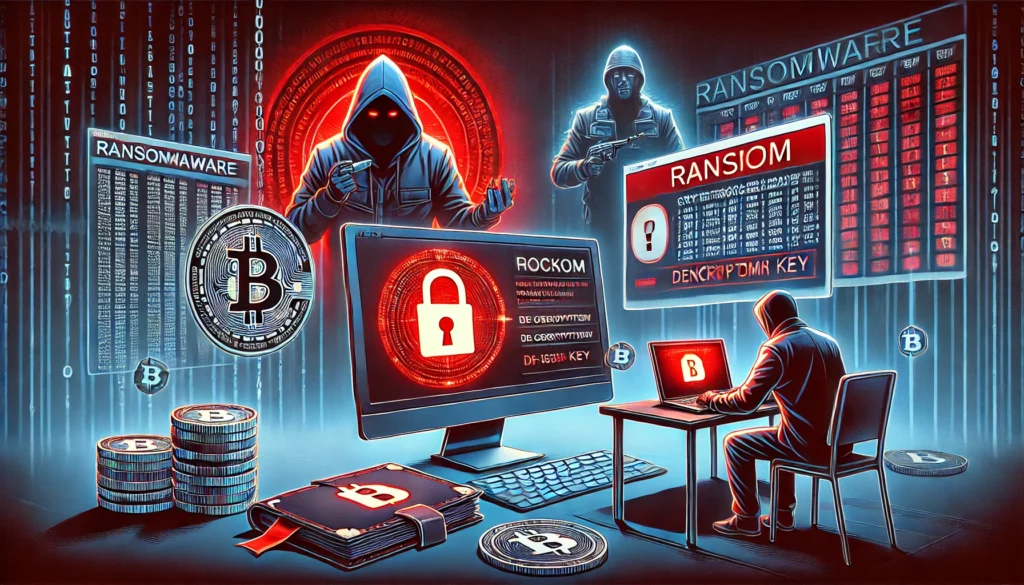In the rapidly evolving world of cryptocurrency, security risks continue to emerge as cybercriminals adapt and exploit vulnerabilities within the digital ecosystem. One of the most alarming threats gaining traction is crypto ransomware, a type of cyberattack where hackers encrypt a victim’s files or digital assets and demand payment in cryptocurrency for their release. As cryptocurrency has become an integral part of global finance, ransomware attacks targeting digital assets have become increasingly sophisticated, posing a significant challenge to both individuals and organizations.
Crypto ransomware has evolved alongside the broader cybersecurity landscape, leveraging the anonymity and decentralized nature of digital currencies to demand ransom from victims. Hackers use various methods to lock users out of their wallets or files, and in some cases, hold an entire organization’s data hostage until the victim pays in cryptocurrency. This article will explore how crypto ransomware works, the tactics employed by cybercriminals, its growing impact on the cryptocurrency world, and the steps individuals and organizations can take to protect themselves from becoming the next victim.
What is Crypto Ransomware?
Crypto ransomware is a type of malware that encrypts files or data on a victim’s computer, network, or digital wallet. Once the files are encrypted, the hacker demands a ransom in cryptocurrency, usually Bitcoin or Monero, for the decryption key that will unlock the data. The key to the attacker’s success lies in the anonymity offered by cryptocurrencies, making it difficult for authorities to trace the payments and catch the criminals.
The ransomware typically works by infiltrating a victim’s device or network through phishing emails, malicious downloads, or exploiting software vulnerabilities. Once the malware is activated, it encrypts files and displays a ransom note, instructing the victim to send a specific amount of cryptocurrency to a wallet address in exchange for the decryption key. The ransomware attackers often impose a time limit for payment, warning the victim that the ransom amount will increase or the files will be permanently lost if payment is not made within the specified period.
Crypto ransomware can target various assets, including files, databases, or digital wallets, where valuable cryptocurrency holdings are stored. In some cases, hackers use ransomware to lock individuals or businesses out of their wallets or to steal private keys. The attackers then demand cryptocurrency payments to either restore access or avoid the permanent loss of assets.
How Crypto Ransomware Attacks Work
Crypto ransomware attacks usually follow a sequence of stages that involve several layers of sophistication and strategy to maximize the chances of success. Here’s a breakdown of how a typical attack unfolds:
1. Delivery of the Malware
The first step in a ransomware attack is the delivery of the malicious software to the victim. This can occur through various methods:
- Phishing Emails: Fraudulent emails are sent to the victim, often disguised as legitimate correspondence from a trusted source (such as a bank, company, or cryptocurrency exchange). These emails may contain malicious links or attachments that, when clicked, download the ransomware onto the victim’s system.
- Malicious Downloads: Hackers can also compromise legitimate software or websites, making them appear safe for download. Once a victim downloads the compromised software, ransomware is activated in the background.
- Exploiting Software Vulnerabilities: Attackers may also take advantage of vulnerabilities in software or devices. For example, outdated operating systems or unpatched security flaws can be targeted to gain unauthorized access to the victim’s network.
2. Encryption of Files and Assets
Once the malware has successfully infiltrated the victim’s system, it begins the encryption process. The ransomware encrypts critical files, databases, and sometimes even cryptocurrency wallet files. This encryption makes the files inaccessible to the victim, effectively locking them out of their own data or assets.
In some cases, ransomware specifically targets cryptocurrency wallet files, such as wallet.dat files in Bitcoin wallets or other similar files in altcoins. These files contain the private keys needed to access and transfer the cryptocurrency. If the victim is unable to regain access, they lose control over their digital assets.
3. Ransom Demand
After the encryption is complete, the ransomware displays a ransom note that informs the victim of the attack and demands payment in cryptocurrency. The note usually provides instructions on how to send the ransom to a specific cryptocurrency wallet address. Victims are given a time frame to pay the ransom, typically within 24 to 72 hours. Failure to comply within the given time may result in the ransom increasing or the encrypted files being permanently destroyed.
In some cases, hackers may even threaten to publish sensitive information or leak business data to add further pressure on the victim to pay up quickly.
4. Payment and Decryption (or Loss)
If the victim decides to pay the ransom, they are typically instructed to send a specific amount of cryptocurrency to a wallet address controlled by the attacker. While some victims who pay the ransom may receive a decryption key to unlock their files, this is not guaranteed. There are many instances where victims send the cryptocurrency but never receive the promised key, leaving them with both the loss of funds and encrypted data.
In some cases, hackers may choose to simply disappear after the ransom is paid, leaving the victim without any recourse. Since cryptocurrency transactions are often anonymous and irreversible, it’s nearly impossible to trace the attackers or recover the funds.
The Growing Impact of Crypto Ransomware
As cryptocurrency continues to grow in popularity and value, ransomware attacks targeting digital assets are becoming more prevalent and sophisticated. In recent years, several high-profile ransomware attacks have targeted cryptocurrency exchanges, DeFi platforms, and individual investors. The following factors are contributing to the rise of crypto ransomware:
1. Increased Value of Digital Assets
Cryptocurrencies such as Bitcoin, Ethereum, and various altcoins have seen significant growth in value, attracting more attention from cybercriminals. As the value of digital assets rises, so does the incentive for hackers to target crypto users and businesses. Crypto ransomware attacks are a lucrative form of cybercrime, as attackers can demand large sums of money in the form of cryptocurrency that is difficult to trace or recover.
2. Anonymity of Cryptocurrency Transactions
The anonymity provided by cryptocurrencies, especially privacy coins like Monero and Zcash, makes them the preferred payment method for ransomware attackers. Cryptocurrency transactions do not rely on centralized banks, making it harder for authorities to track or reverse payments. This gives attackers a layer of protection, allowing them to carry out ransomware campaigns with relative ease and less risk of detection.
3. Widespread Use of Cryptocurrency for Online Transactions
Cryptocurrencies are increasingly being used in everyday transactions, including on darknet marketplaces and within the wider financial ecosystem. This accessibility means that cybercriminals can easily demand payments in cryptocurrencies, knowing that many businesses and individuals are familiar with how to buy, send, and receive digital assets.
How to Protect Yourself from Crypto Ransomware
While ransomware attacks are a significant threat, there are steps individuals and organizations can take to protect their digital assets and reduce the risk of falling victim to these types of attacks.
1. Regular Backups
One of the best ways to protect yourself from ransomware is to regularly back up your important data. Make sure to back up your cryptocurrency wallet and private keys in multiple secure locations, including hardware wallets and offline storage. By doing so, even if your wallet is compromised, you can recover your funds.
2. Use Strong Security Measures
Always ensure your devices are equipped with strong security software, including firewalls, anti-malware programs, and two-factor authentication (2FA). For online crypto transactions, consider using hardware wallets, which store private keys offline and are more resistant to ransomware attacks.
3. Be Cautious with Emails and Links
Always be cautious when opening unsolicited emails or clicking on links from unfamiliar sources. Phishing emails are one of the most common ways ransomware is delivered, so verifying the authenticity of messages, particularly those asking for personal information or access to your digital assets, is essential.
4. Stay Updated on Software and Wallet Security
Ensure that your cryptocurrency wallets, devices, and software are updated with the latest security patches. Ransomware often exploits vulnerabilities in outdated software, so maintaining up-to-date systems is a critical part of defense.
Conclusion on Crypto ransomware
Crypto ransomware has emerged as one of the most serious and growing threats to digital asset holders. The combination of high-value cryptocurrencies and the anonymity of blockchain transactions has created an ideal environment for cybercriminals to target individuals, businesses, and crypto platforms. Ransomware attacks can be devastating, not only in terms of financial loss but also in the long-term effects on reputation and business operations.
However, by adopting proactive security measures such as regular backups, robust authentication, and cautious online behavior, individuals and organizations can significantly reduce the risk of falling victim to crypto ransomware. As the cryptocurrency market continues to grow, it is vital for users to remain vigilant and informed about the ever-evolving security threats and to take the necessary steps to safeguard their assets.


